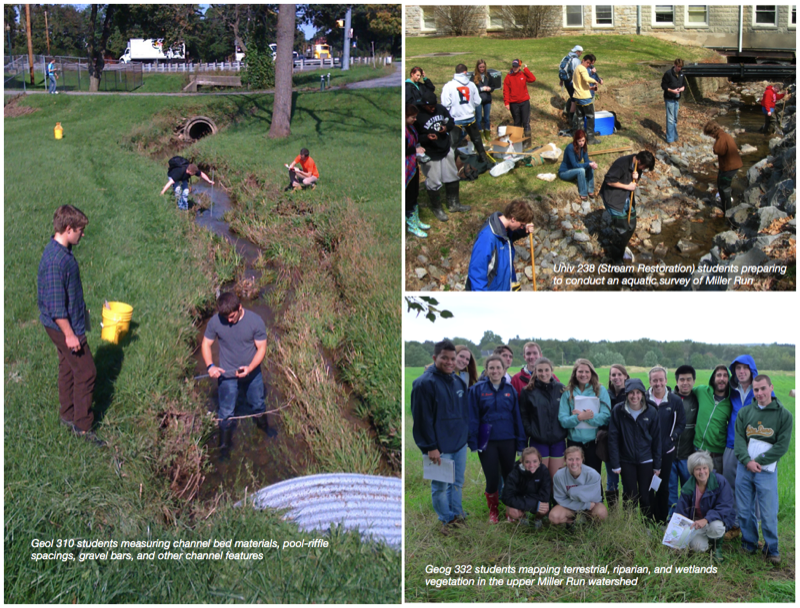
Students and faculty working together
Creating new learning experiences and research opportunities
For decades, faculty and students have commented on how nice it would be to see the straightened, concrete and rip-rap lined “drainage ditch” running through campus to look more like a natural stream it used to be. Attention to this idea gained momentum since 2005 as state and federal environmental agencies began to partner with local conservation districts and watershed groups on projects in Buffalo Creek, Penns Creek, White Deer Creek, and most recently Bull Run. Students saw both environmental scholarship and stewardship opportunities for Bucknell to begin looking at how it can improve Miller Run.
In 2007, Alison Schaffer’s honors thesis provided the first systematic assessments of the watershed; stream gaging stations were installed at the Art Barn and at Bucknell Hall and measured stream discharge and water chemistry. In 2009, with help from the Susquehanna River Initiative, Craig Kochel (Geology) and Matt McTammany (Biology), developed a new course - Stream Restoration (UNIV 298) - where students chose to take a much closer look at Miller Run and begin to explore practical approaches that could reduce flooding and improve ecology.
In 2010, this work was catapulted forward by a $178,000 Growing Greener grant from DEP to Bucknell to restore the headwater regions of Miller Run. Building upon the previous efforts, over 80 students and 11 faculty in seven different classes have been collecting and analyzing information on the channel – its hydrology and water quality during base flow and flood conditions, sediment loads, channel cross-section and longitudinal profile, channel-bed sediments, physical impairments, and ecological survey (invertebrates and fish).
In 2007, Alison Schaffer’s honors thesis provided the first systematic assessments of the watershed; stream gaging stations were installed at the Art Barn and at Bucknell Hall and measured stream discharge and water chemistry. In 2009, with help from the Susquehanna River Initiative, Craig Kochel (Geology) and Matt McTammany (Biology), developed a new course - Stream Restoration (UNIV 298) - where students chose to take a much closer look at Miller Run and begin to explore practical approaches that could reduce flooding and improve ecology.
In 2010, this work was catapulted forward by a $178,000 Growing Greener grant from DEP to Bucknell to restore the headwater regions of Miller Run. Building upon the previous efforts, over 80 students and 11 faculty in seven different classes have been collecting and analyzing information on the channel – its hydrology and water quality during base flow and flood conditions, sediment loads, channel cross-section and longitudinal profile, channel-bed sediments, physical impairments, and ecological survey (invertebrates and fish).
In the spring semester, Civil and Environmental Engineering studies under the direction of Rich Crago and Matt Higgins will help us better understand the water quality and hydrology of the upper watershed and how storm water wetlands and other features can be incorporated into the restoration plan. This level of interaction among the academic interaction toward a shared university service endeavor is something very special and invigorating.
Over the past 25 years, I can’t remember a time when so many students, faculty and staff from across campus have interacted through teaching and research projects toward a campus environmental stewardship endeavor. It’s wonderful to see this.
R. Craig Kochel
Professor of Geology
